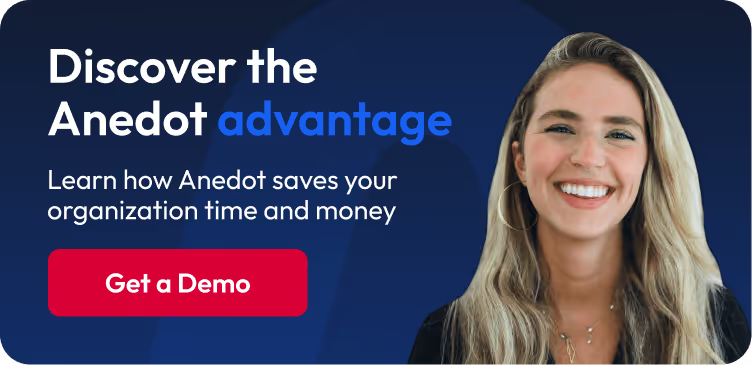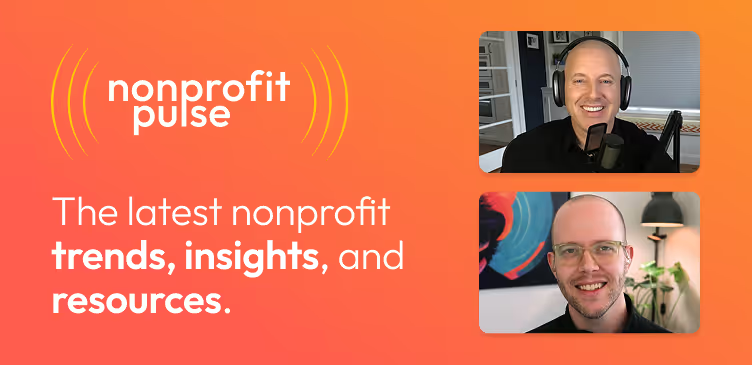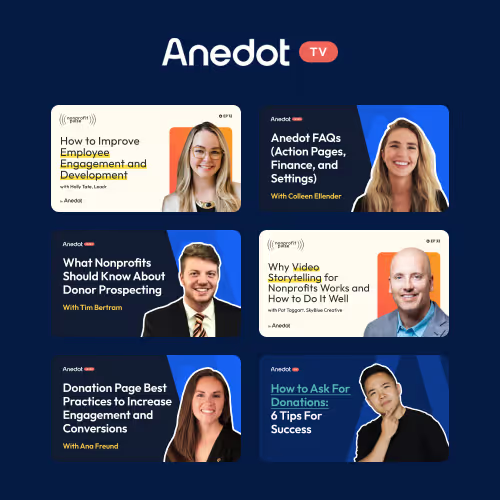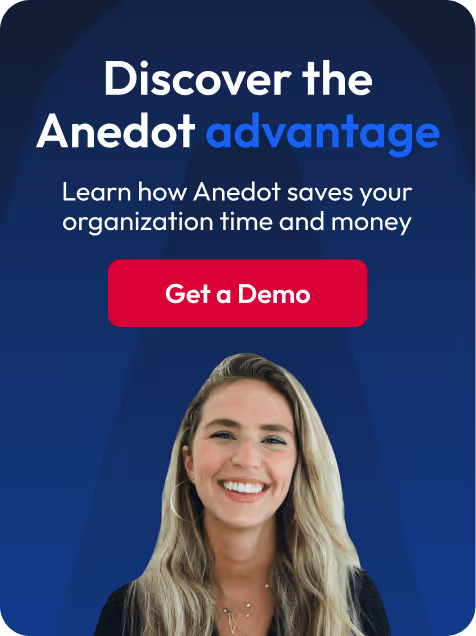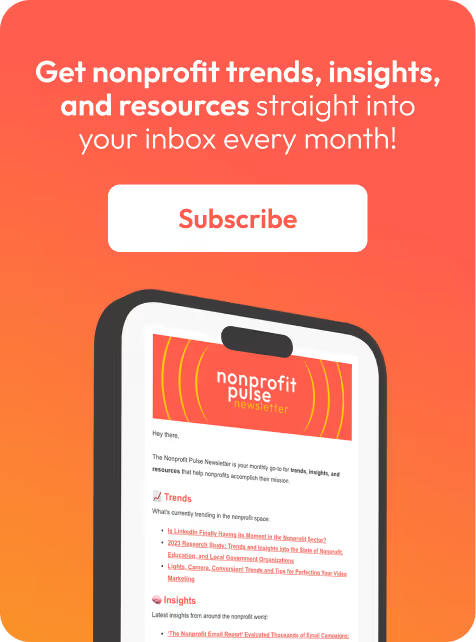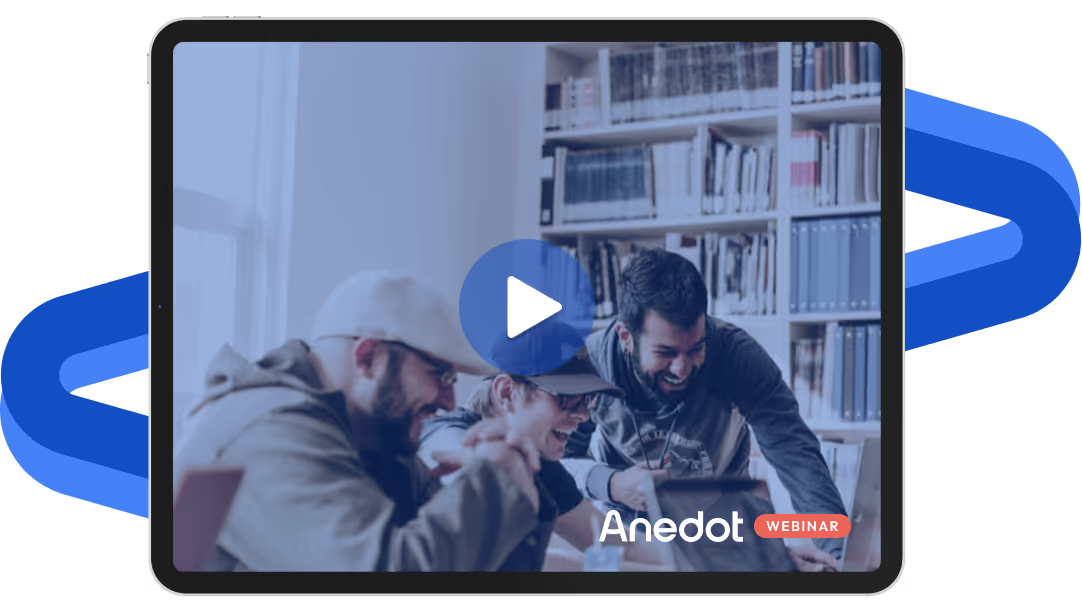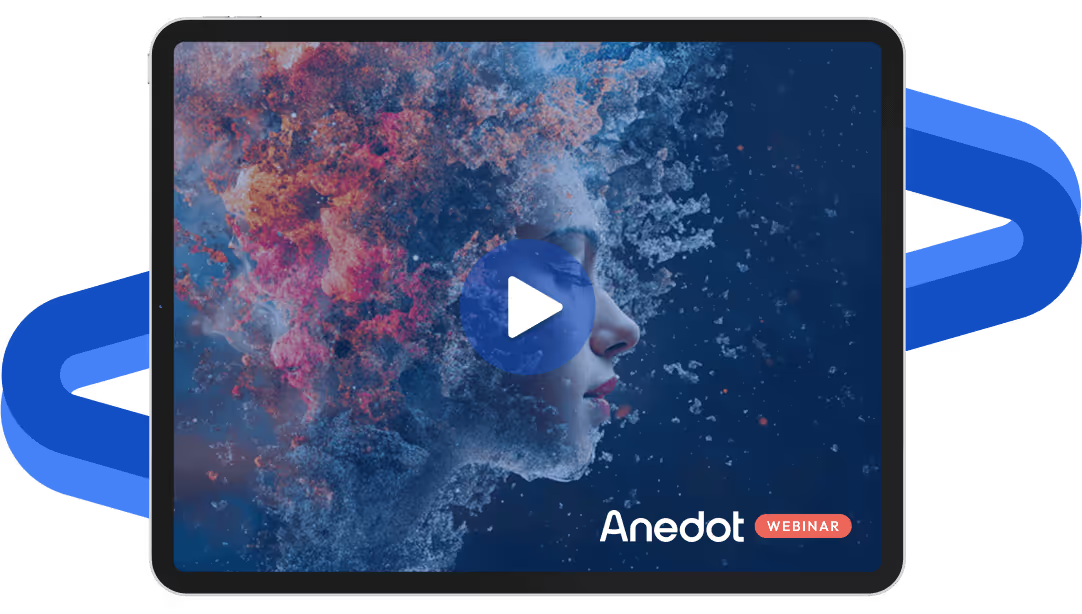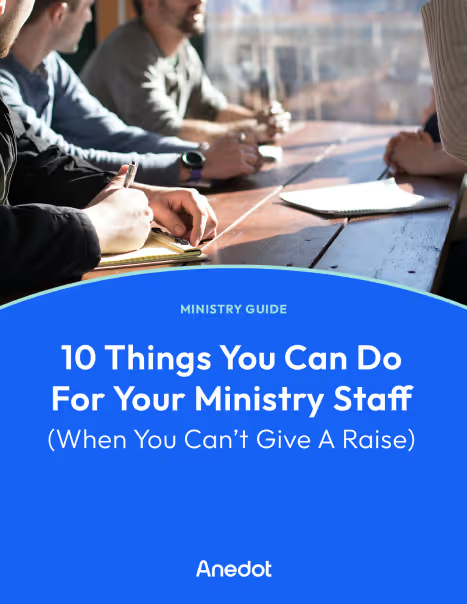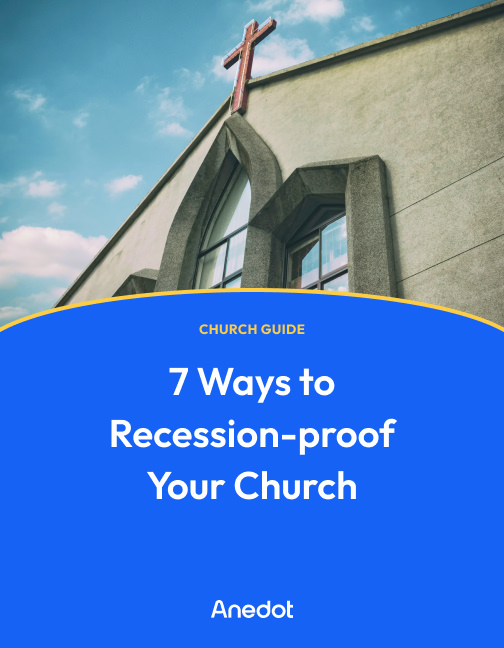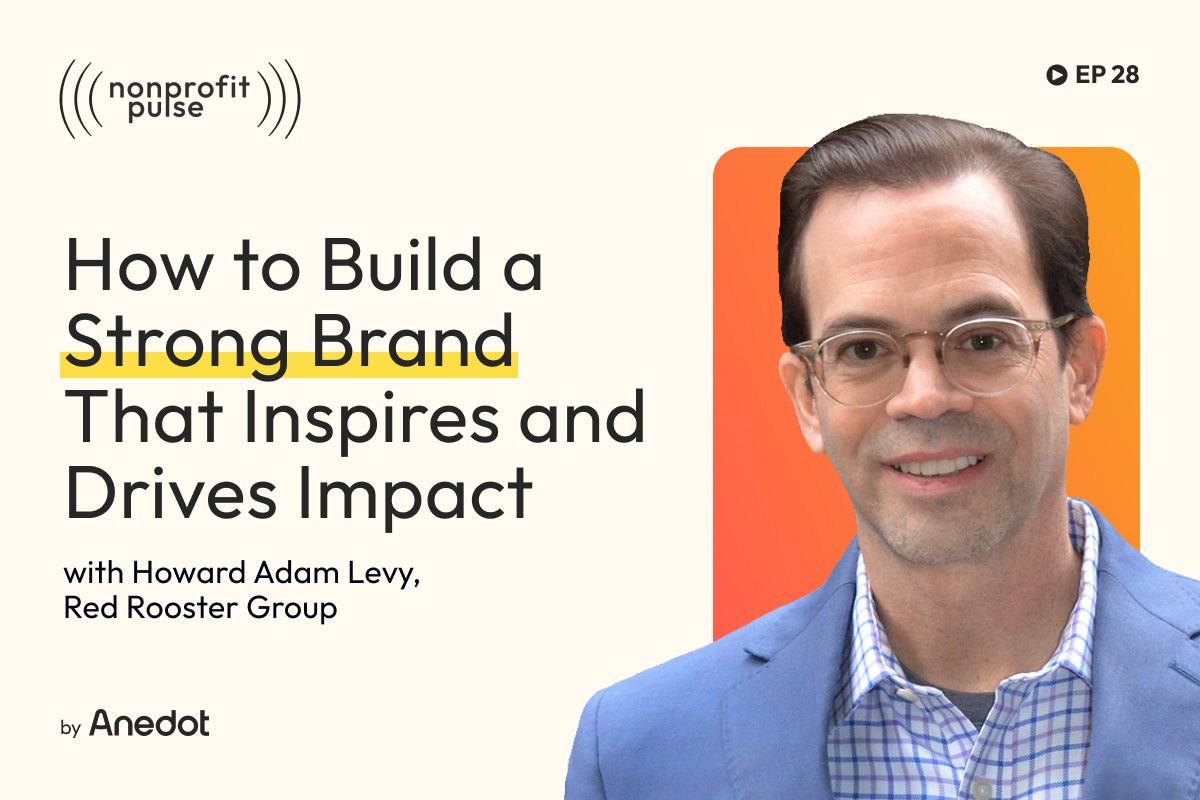Podcast episode transcript ↓
Josh:
Recurring donors are the backbone of sustainable fundraising, but keeping them isn’t always easy.
From inconsistent communication to a lack of personal connection, there are small missteps that can lead to big losses over time.
So, why do recurring donors stop giving? How can you create an experience that keeps supporters engaged?
And what practical steps can you take today to build lasting loyalty and boost retention?
I’m Josh with Anedot, and welcome to Nonprofit Pulse, where we explore trends, insights, and resources that help nonprofits accomplish their mission.
On this episode, we’re joined by James Misner on how to maximize donor retention and overcome the loss of recurring givers.
James is the founder and owner of The Kipos Group. With over 20 years of fundraising leadership, James brings both best practice and practical advice to clients.
He helps organizations grow their revenue so that they can scale solutions to some of the world's most difficult problems.
Hey James, thanks for joining us on Nonprofit Pulse.
James:
Hey, Josh, it's so great to be here with you today.
Why recurring donors stop giving and how nonprofits can respond
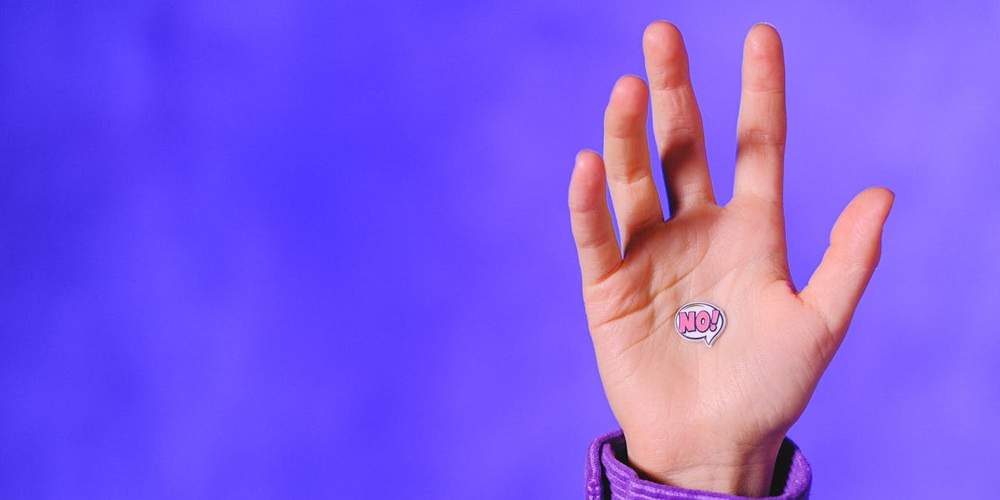
Josh:
Yeah, excited for our topic today.
Today we're talking about how to maximize donor retention and overcome the loss of recurring givers, which, hey, what nonprofit doesn't want to do that?
It's on the mind of I think every leader is how do we how do we build on our momentum with, recurring givers?
And then when we lose them, as it happens, how do we overcome that?
So kind of starting off, let's start with the why and the reasons behind why recurring donors stop giving.
And really, how can nonprofits address these challenges? What would you say to our audience?
James:
Yeah, Josh, I think there's three reasons why people stop giving, as part of a monthly giving program.
One is they've had a life event happen.
Most monthly givers, don't have the income to be able to sustain their monthly gift if they were to lose a job or something like that.
It's a big reason why people leave, and it actually causes them a significant amount of pain.
They don't want to have to hit, you know, cancel on that monthly subscription. That's one.
Also with life events sometimes people pass away, sometimes, you know, other things happen or they move out of your area if you're a geographic focused nonprofit, but with a life event, you just have to stay close to people.
There's really nothing you can do to control it.
The other two reasons are entirely within your control.
The second reason people stop giving, is because you haven't let them know that they're making a difference.
They don't know that their 50 bucks, 75 bucks, $100 a month is making an impact.
And so when they look at it, leaving their credit card statement or their bank statement every month, they just wonder, wow, is this being used in the best way?
This nonprofit's not letting me know. That is entirely within your control to fix.
And the third reason monthly donors lapse is that they don't know that they've lapsed.
Okay. How many recurring things do we have coming out of our credit card right now? We have Amazon Prime, we have Netflix, we have Disney Plus. If you have kids, you have Hulu, you have you have you have you have.
And when your credit card changes, the expiration date comes up, unless the nonprofit is doing a really great job updating you and letting you know, hey, you need to go back in and update that or they have the credit card expiration date, you know, plug in just to fix it for you.
They might not know that they're lapsed because it just has slipped their mind.
You think about them way more than they think about you. Those are the three main reasons Josh.
How to create a donor experience that builds long-term loyalty
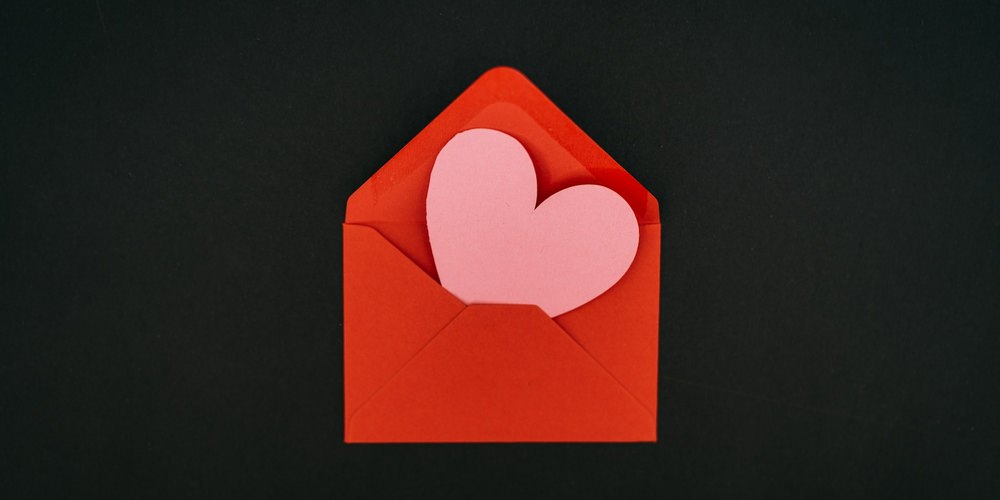
Josh:
Super helpful and kind of thinking long term, how can nonprofits create a donor experiences that, or a donor experience that really encourages that long time giving and loyalty?
You know, you mentioned, communicating impact, anything else kind of around that question?
James:
Yeah. When we buy anything, whether it's a house or a car, most humans experience a form of buyer's remorse almost instantly afterwards.
Should I, could I have done it differently? The shoulda, woulda, coulda, you know, mentality.
Same is true when somebody signs up for your monthly giving product. And so you have to reinforce that this was an amazing decision from the minute they hit submit on the website.
Okay. So you need to enroll them in an automated welcome series. That's just not thank you seven different times, but it's hey, here's the impact you're making. Thank you. Hey, here's a story of a changed life. Thank you. Here's a story of a changed community. Thank you.
You need to be constantly reinforcing that they made a great decision through a welcome series when they sign up, they should receive a welcome packet and old fashioned, mail it to somebody welcome packet.
When they join your monthly giving program, you are doing everything that you possibly can to keep that buyer's remorse from setting in.
And then at minimum, they need to hear from you twice a month after that. Okay.
Thought leadership pieces, blogs, stories of impact, thank you.
You need to constantly do everything you can so that they feel that this was the most amazing, wisest investment they could make with their 50 bucks a month.
Josh:
I love that, and I love the physical mail aspect.
Because you know what? I've received those too where you know, when you're giving online, when you're living online, there's something that's not quite 100% real about it. Right?
You go to a website and you see these stories, say, hey, I want to contribute to this cause, I want to be a part of this.
I want to help people serve people through my gift. And you give and you go on with your day.
When a week from then 4 or 5 days from then, you get this packet in the mail showing, wow, this $50 a month is going to do this.
And here's the executive director, here's some of the staff, and here's some of the volunteers.
The people being impacted by their work. It just feels so real at that point of I'm so glad I did that. This is going to make a difference.
So I love the physical mail aspect of that, which is an investment, I think, or a lot of nonprofits would look at the expense side of that, but I think it's well worth the investment.
James:
But just think about, like, longevity for a second, okay? When you get an email, you can only see 10, 12, 15 emails at a time in your inbox.
It doesn't take more than 30, 45, 60 minutes for a new email just to go down. Okay.
And if you haven't opened it, you're probably not going to, especially if like you have a work email and a Gmail or something like that, you're just not going to get to it.
When that package shows up, it sits in your house for an average 4 to 6 months, which keeps your brand in their mind, in their kitchen when they're getting coffee, when they drop today's mail off at the stack on wherever you throw your mail, when you come in your house or your keys down, you're there in the house with them.
Who doesn't want that? And yeah, it's more expensive, but your donor is going to stay longer. Which means you're going to make more money from them.
Communication strategies that keep donors engaged and invested

Josh:
Love that. And that's a great segue into our next question.
Thinking about, keeping donors engaged, and it's really always a challenge.
You know, one way would be, as you just mentioned, having a piece of mail or a guide or a resource that can go on the coffee table or the kitchen table and keep the organization kind of front of mind for folks.
But what are some other communication strategies that you have found really most effective in keeping donors engaged and invested in the work of the organization?
James:
People are going to hate this because it reminds them of the pandemic.
I think virtual events and town halls are an amazing way to keep monthly donors engaged, and this data shows us that a good number will actually show up for your event, but an even higher number will watch it on replay later on.
They’ll watch it or listen to it at the gym on their commute.
You know, during lunch. Something like that. Update your donors. Bring them together in community, even if it's virtually.
Let them hear stories directly from program staff, not just from fundraising staff and executives. Let them hear from other donors. Let them meet other donors.
These are all really simple, free, or very affordable ways to keep your donors connected. And there's really no reason not to do them.
I think we spent a lot, way too much time thinking about well would donors like this or not, instead of just doing it and seeing how they behave.
Then when you put something out there, your donors care about your work, they love you and they love your work. So put it out there and invite them to come.
Why donor appreciation matters and how to show it creatively

Josh:
So a lot of nonprofits are really leaning into initiatives around donor appreciation.
What would you say about donor appreciation? How important is it?
And what are some creative ways that nonprofits can show gratitude on a regular, consistent basis?
James:
This is such an interesting question, because what donors say and what donors do in this area are very different.
Okay. It's, I forget what social scientists call it. But there's a bias when we answer surveys or answer questions about this.
So, for example, hey, you don't need to show me appreciation. You don't need to go out of your way to thank me.
A lot of donors will tell you that. But then what happens when you don't do that, they lapse, okay, because they don't feel appreciated.
So they're telling you one thing and their behavior is different.
If you take two cohorts and you thank one and the normal way and you kind of ratchet it down for the other based on their preference, quote unquote, the group that you kept, what you thought you should do is going to perform better.
So we can’t always listen to what donors say. We have to watch what they actually do when it comes to appreciation.
Another really interesting thing when it comes to monthly donors here is a lot of people like to thank donors on their anniversary.
Okay. And appreciate them. You've been with us for one year. Do you know what that signals to the donor?
I did it, my time is up. I can hit unsubscribe right now. It's so counterintuitive for us as a nonprofit. Like we should thank them every year.
No, it gives them an excuse to unsubscribe. You should just thank them at random points in time and show them that they are making a difference.
So if you're sending your two emails every month, maybe at month nine of the year, they get a handwritten note and there's no reason why it just comes out of the blue.
You might have a reason in your system, but the donor has no idea that it's month nine, right? They're not paying that much attention.
So appreciate them. Watch what they do and respond to what they do, not what they say.
And be very wary of anniversary celebrations because it gives people an excuse to unsubscribe.
The role of storytelling in donor retention and how to use it well
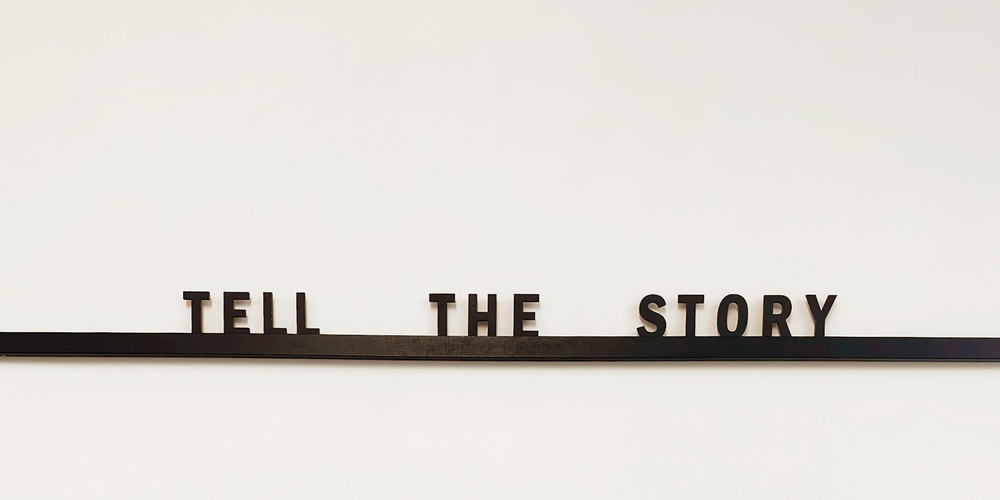
Josh:
Thinking about storytelling and how to get those stories in front of your donors. And really just what role storytelling plays in donor retention.
How can nonprofits begin that work? Or even, lean in more and make their storytelling for donor retention even better?
James:
It's all about story. Everything is about, the human brain works off of story.
Okay. If you were to measure two cohorts again, going back to measuring, I think measuring what donors do is so important, Josh.
Measure two cohorts and give one data and one stories. The ones with the stories are going to outperform on every every available metrics that you can measure.
Everything needs to be a story. Your annual report needs to be a story. The beneficiary stories need to be written like stories.
We don't start with once upon a time, but kind of start with once upon a time, there was this guy named Josh, and he was X, Y, Z. It was a problem.
He encountered our work, we helped him, and now he is, you know, ABC, whatever it is.
You have to communicate everything like a story, because facts fade but stories stick.
Josh:
I love that. And even just thinking on the donor retention side of how when a story hits your inbox or hits your mailbox, and it's a compelling story of how that giving, accomplished this impact, that's powerful and bringing them back when they're thinking, oh, I am hitting my one year point in this monthly program.
Or hey, I did have a life event. I've been thinking about canceling my recurring gift.
Those stories at the right time, can have a huge impact in donor retention and kind of keeping people on board with the mission.
James:
Yeah, I remember I used to lead a really large fundraising team of about 40 people, and I would often get to meet some of the major donors or foundations at the very end of their process of becoming major donors and foundations.
And if it was appropriate, I would ask, at what moment did you know that this was for you?
Eight times out of ten, they would tell me a story about the story that they heard from one of the staff I heard about this thing in Haiti, I heard about this thing with a refugee, and they could tell the story as if they had been there.
No one ever said because of this data sheet, no one ever said because of numbers.
They said it because of this. And they told me this story Josh, like, I hadn't heard the story before.
Like I wasn't part of crafting the story and training the team on how to put the story together.
Which shows me that this story stuck. It went really deep down, inside of them, so storytelling is the end all be all in fundraising at every level.
How to use data and analytics to re-engage lapsed donors
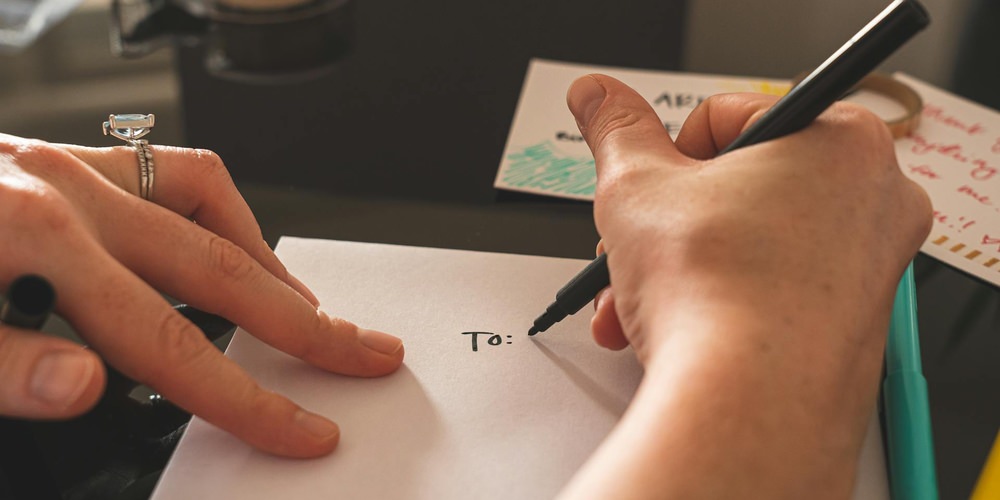
Josh:
I love that. That's so cool.
So thinking about analytics and data, what are the ways that nonprofit leaders can leverage their data to reengage lapsed donors or even kind of find the trends of, yeah, what happens with our donors to become lapsed donors?
Are there any behaviors there? What would you say to our audience?
James:
I think there's so many ways to do this. And I think utilizing data is something the for profit world has risen to the challenge of especially with AI in these past two years.
And it's something the nonprofit world is lagging so far behind in. Where do I want to start there?
Okay. You can set up in your CRM if you have an integrated marketing CRM platform to see when donors stop opening your emails, okay?
When they stop, maybe they were opening 80% of the emails and it's slowly going down to 70, 60, 50 clear sign in the data that they're losing interest.
So what do we have to do? Handwritten notes, phone calls, text messages, invite them to something.
Okay. That's with monthly. For other non monthly donors, you need to set up early warning systems in the data.
Hey, it looks like they give every year in December or in August or whatever it is. Okay. We're getting really close to that again. And we haven't heard from this person.
You need to be able to do that. At the same time, you can use your data to reengage lapsed donors. You could send them a survey and ask them, why did you lapse?
What did we do wrong? Things like that. And then use that to build out systems to keep other donors like them from lapsing and just ask those survey donors, hey, what can we do to win you back?
And if they want to be won back, they'll tell you exactly how to do it. So I think there's so many ways, Josh, to use data to do this.
I think most of us, just quite haven't figured out how to get all the necessary inputs in there because it's really time consuming.
So we get the outputs from our data systems that we need. And that's why hiring a great dev ops director, if you don't have one, is probably something you should do.
How to personalize outreach to connect donors to your mission

Josh:
So thinking about that engagement piece, how can nonprofits really execute well on personalized outreach to make donors feel more seen, more connected in the overall mission of the organization?
James:
Yeah, it changes in my mind based on the donor segment. Okay. So your major donors, they need people that are in close proximity to them, right?
So if you're a national organization or even regional, if you have a major giving officer that's on the other side of the country or the other side of the state, and they can only see the person once or twice a year, and they're not at the same social events together.
They don't run in the same circles. It really is a challenge. I think network density is very important in the major donor space.
You're in Austin. I'm in DC. You need a major donor person in Texas. You need one in the Mid-Atlantic. You need to be close to people.
And I know that's an expense for nonprofits, but you have to be able to invest if you really want to see growth and engagement.
Once you get into mid-level and monthly giving, you can do a lot more of it virtually. And people understand that, hey, it's a national or a regional nonprofit.
It's not going to be right here in my community. But it's nice is every once in a while, every year, every two years, there's something within driving distance, of them to be able to do.
It's almost like you mentioned with email and snail mail, the difference between like the fake online experience and the in real life experience. Yes. It just makes it so much richer for people.
We want to give them that experience. I think another underutilized asset in the nonprofit playbook is a site visit, whether that's a vision trip to another country or a program visit, allowing people to come in and see the work and interact with the program participants, that their giving is helping to change their lives.
You can't get a better experience than that. So don't undersell that tool in your toolbox as well.
Don't overuse it, but also don't under use that one.
Josh:
So it sounds like proximity, proximity, proximity.
Make sure you're close enough to your major givers, and even the mid-levels to where you can spend time, whether that's on site, whether that's reviewing a program or observing a program in the community, but trying to keep it real, as much as possible, kind of off of the digital side, even though the digital side plays a huge role, the positives of that physical presence is huge.
James:
It's absolutely right. And let's go back to the three reasons people lapse, okay?
One's a life event. If somebody experiences a life event but you're in close proximity to them, they'll tell you about it.
If they lost a job. I mean, I'm in Washington, D.C. right now. A lot of people have lost their jobs in the past four months.
If you know those people, they will say, hey, I got laid off today. I need to pause on this until I figure my life out.
If you've never talked to them before, they're not going to tell you that, just because it'd be weird to send a stranger that email. So proximity matters.
The second reason, remember, was they don't know where their money's going. And if it's making a difference.
If they're seeing you often, you're going to be telling them. And if you're not telling them, that's a problem with you, not with the donor.
Third, they don't know their lapsed. But if you're there, they're going to remember you more than if you're not there.
And if they haven't given, they'll also remember that. So proximity is so important.
Practical steps nonprofits can take to improve donor retention today

Josh:
So thinking of practical steps as we kind of round out the interview, what are some practical steps that organizations can take right now, today to improve their donor retention rates?
James:
Okay. Number one, you have to communicate impact.
So I hear nonprofits all the time. We don't want to send more emails out because we're afraid we're going to increase in our unsubscribes.
Unsubscribes is almost like a bell curve, right? If you under send the emails, you will get a lot of unsubscribes when you send one, because who are you?
Again, I don't know who you are. Even if they signed up, if you send them every two days, like Old Navy, or Bed Bath Body Works or whatever, they're going to unsubscribe.
People who give to you want to hear from you. So an email a week or every other week, especially if there's rich content in there, stories of impact, thought leadership, frontline reports.
They're going to eat it up. They're going to love it. And even if they don't read it, they're going to feel comfortable knowing that you are reaching out to them.
So you need to need to need to need to communicate impact with your donors. Number one.
Number two, you need to create an early warning system so you know when somebody is about to lapse, okay.
It is easier to keep somebody from lapsing than to win them back after they have lapsed. So create those early warning systems.
And then three, I think every year or two, nonprofits should do a full throated lapsed donor campaign trying to win back their lapsed donors.
When I work with our clients, Josh, they are always shocked at the number of touch points that I tell them is needed.
The average lapsed donor needs between 17 and 20 touch points to reactivate because unless a life event happened, you as the nonprofit did something wrong.
Okay, and so you need to earn back that trust and show them that this time is going to be different.
I remember a story of a staff member of mine who called me one day, half laughing and half crying.
We were doing a massive lapsed donor campaign. This was kind of middle of the pandemic. We went back ten years trying to reactivate lapsed donors.
So donors that none of us knew because we hadn’t worked there that long. And I told her like, just keep trying. It's going to work. Just keep trying.
And that day, she called in laughing and crying. $50,000 gift from the 17th touchpoint. She was like, you were actually right. It was actually 17.
Because the data told me that's what it takes. And $50,000 gift from a lapsed donor that had been lapsed for almost a decade.
And that person went on to 100,000, and now a quarter million, a year for them.
So do a lapsed donor campaign. It can't hurt. They're already gone.
Josh:
What a great story. I mean, of perseverance, because I think if you spoke to most nonprofit leaders right now and said, hey, we're going to have 17 to 18 touch points with our lapsed donors, they would be some immediate concern about whoa, whoa, whoa, pump the brakes.
That sounds too much. So hearing the data kind of support that idea and that playbook is super helpful.
James:
It has to be 17 to 20 over the right length of time.
If it's in a month, that's way too much. But if it's over 6 to 9 months, it starts to feel pretty good.
Closing thoughts

Josh:
So thinking about resources, what are some resources around this topic that you'd recommend to our audience?
James:
Oh that's great. Number one, DonorSearch. Jay Frost and I did a whole webinar on how to avoid lapsed donors and win them back.
So just Google that on DonorSearch. It's an hour long and literally breaks apart the entire campaign that you would need to build to win them back. I think that's kind of number one.
Number two, every organization is different.
I mentioned the survey idea. I think going out and actually surveying and hearing from your donors because they will have lapsed for different nuanced reasons, same big categories, but different nuanced reasons than the nonprofit next door, that's another great resource to do it.
And then there's an amazing book out there called How to Never Lose a Customer Again.
Okay. It’s a 100 ways, 100 ideas how to never lose a customer, written for the for profit space.
But anybody with a brain can quickly contextualize that for the nonprofit space. 100 ideas of how to never lose a donor again. I would highly recommend that book to everybody.
Josh:
Awesome, awesome. And then, thinking about our last question here, my favorite question of every episode.
James, if you were on stage in front of a thousand nonprofit leaders and could share one sentence, one pithy short thing with that audience around today's topic, which is how to maximize donor retention and overcome the loss of recurring givers, what would you say?
James:
It's all within your control. Stop being fatalist. It's not the market. It's not that people don't care.
It's that you need to act, behave, and engage differently to see the results that you want.
And if you keep doing the same thing over and over again, you're going to get the same results over and over again. So start changing.
Josh:
Love it. Love. It's such a helpful episode.
James, thanks for all your wisdom here and as always for our audience, check out Nonprofitpulse.com for show notes.
You can find recommended resources there, show notes and how to connect with James.
James, again, just thanks so much for sharing.
And, I hope everyone take something away from this episode and starts leaning into donor retention and really how to engage those lapsed givers.
I think there's a lot of revenue there for folks who just aren't doing anything. So James, thanks again.
James:
Thanks so much, Josh. Great being here today.
Josh:
Hey, thanks for listening.
If you enjoyed this conversation, please share or leave us a rating and review wherever you listen to podcasts.
Also, head on over to Nonprofitpulse.com to sign up for our monthly newsletter, as well as check out all the links and resources in the show notes. We’ll see you next time.
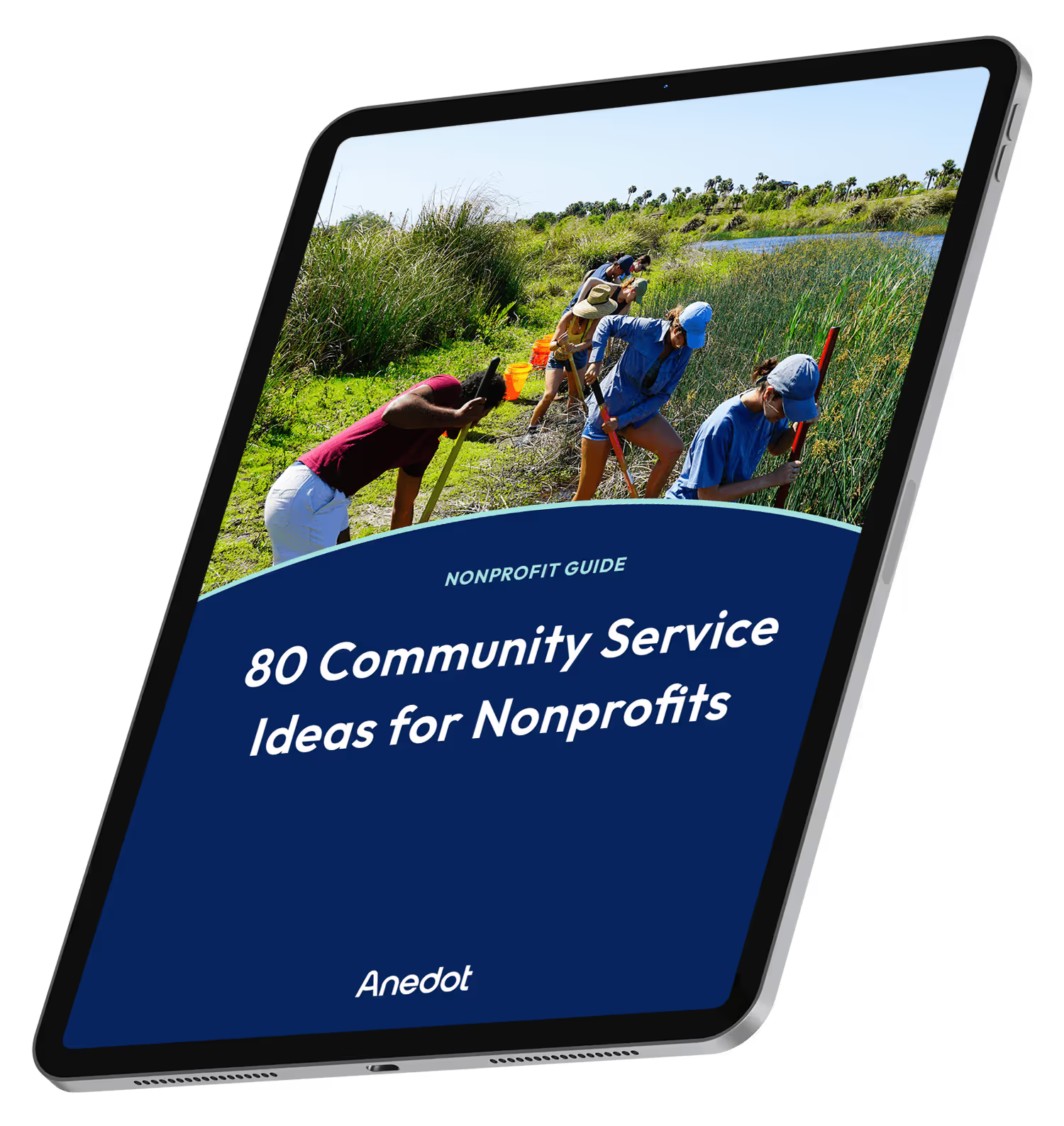
80 Community Service Ideas for Nonprofits
